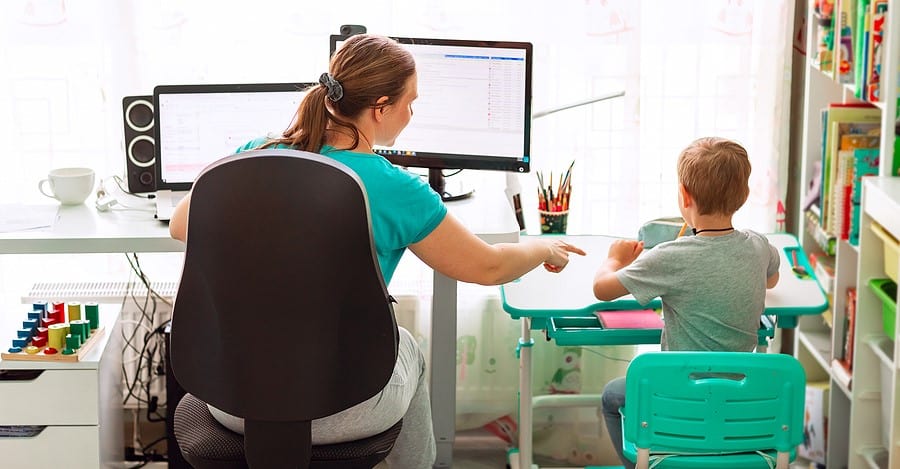
The world has become a very different place as COVID-19 (and our response to it) has impacted every aspect of our lives. Beyond the dangers of the coronavirus itself, our well-being is threatened by the social, political, and economic consequences of the pandemic. And as we know, the impact is not proportional across populations. Women are bearing an increased burden as a result of COVID-19 and as a result, according to the Bureau of Labor Statistics (BLS), 865,000 women have made the difficult decision to leave the economy and set aside their careers to absorb the lack of childcare options related to the pandemic.
As working parents across the U.S. attempt to figure out how to keep up with their workplace responsibilities and make sure that their children are safe and do not fall behind in school, we are, as a nation, reversing recent gains in gender equity.
The women dropping out the workforce, potentially forever, are our colleagues, teammates, and friends. This is happening right here, in our backyards, and in our industry.

I spoke with Dr. Susan Windham-Bannister, President and CEO of Biomedical Growth Strategies and Chair of the National Board of the Association of Women in Science (AWIS). Dr. Bannister said that “we know from research studies, including work by AWIS, that retention of women in STEM professions already was a challenge prior to the pandemic. Some estimates suggest that 60% of women in STEM careers choose to leave the field. So further erosion of the STEM talent represented by women is especially alarming.”
In short, let’s consider why the erosion of women’s workplace gains matters to leadership and to science:
- Many of the women dropping out hold senior-level positions or are in a position to advance
- Their exit means the already-abysmal representation of women in leadership will get worse
- It unwinds progress:
- The departure from the workplace will reduce women’s lifetime earning potential and exacerbate the existing structural inequities surrounding their advancement and abilities to succeed in the workforce
- We lose mentors, sponsors, and role models.
How has the pandemic added to the childcare crisis/motherhood penalty?
- The recent McKinsey & Company research report (the largest study of the state of women in corporate America) found:
- 76% of mothers with children under age 10 say childcare has been among their top three challenges during the pandemic
- Latina moms are 1.6x more likely to be the breadwinner as well as responsible for all childcare and housework, while Black moms are twice as likely. These burdens are compounded by the fact that these mothers also face persistent bias in the workplace
- As dual-income households around the country decide that one parent needs to stay home with the kids, moms are typically the ones to leave their jobs
- For single mothers, there’s almost no escape. There is no second earner to fall back on
We need organizations and leadership to step up! Sheryl Sandberg, Founder of LeanIn.org says “companies with more women in senior leadership perform better; have better cultures; and are more likely to raise concerns such as work/life flexibility and equal pay. It’s critical that companies double down on supporting women right now. This means rethinking goals and expectations set before the pandemic. It also means making it OK for women to set boundaries.”
Some corporations are evaluating their operations and are:
- Thinking about adding more flexibility into the workweek
- Open to a remote/in-person hybrid future
- Reducing business travel for employees
- Creating effective sponsorship programs as well as incorporating succession planning and returnships (people returning to the workforce after leaving at least 2 – 3 years) in our recovery efforts
We need our male allies, leaders, and colleagues as partners to build awareness of the crisis impact.
We need male leadership to:
- Ensure women are included in key decisions
- Support working parents and caregivers, period!
- Offer and connect to relevant resources in the community
- Address the motherhood penalty and unconscious bias about working moms
- Invest in women-focused employees resources groups (ERGs) and in networks like AWIS, BWISE, HBA, WEST, WIB, and WOCIP
For biopharma, when you hinder careers, you hinder science. The rate at which women are leaving the workforce will affect research, phases of development, and potentially transformative medicine. U.S. competitiveness will suffer if this trend continues. This will decrease patient outcomes. This will interrupt our continuous effort to improve the quality, efficacy, and cost of care. Patients are depending on us to act. If we do not solve for this looming crisis, we do so at their and our own peril.
To learn more about the impact of women leaving the workforce, join us for our next Make Shift Happen with ED&I on October 26th. Register here.
Resources:
- Employment Situation Summary, U.S. Bureau of Labor Statistics, September 2020, https://www.bls.gov/news.release/empsit.nr0.htm
- Women in the Workplace 2020 Report: Corporate America is at Critical Crossroads, McKinsey & Company, September 30, 2020 https://www.mckinsey.com/featured-insights/diversity-and-inclusion/women-in-the-workplace
- Senior-level women are leaving the workforce. If businesses don’t act, we’ll lose our best leaders, by Sheryl Sandberg & Rachel Thomas, Fortune Magazine, October 9, 2020, https://fortune.com/2020/10/09/sheryl-sandberg-lean-in-rachel-thomas-women-leaving-workforce/